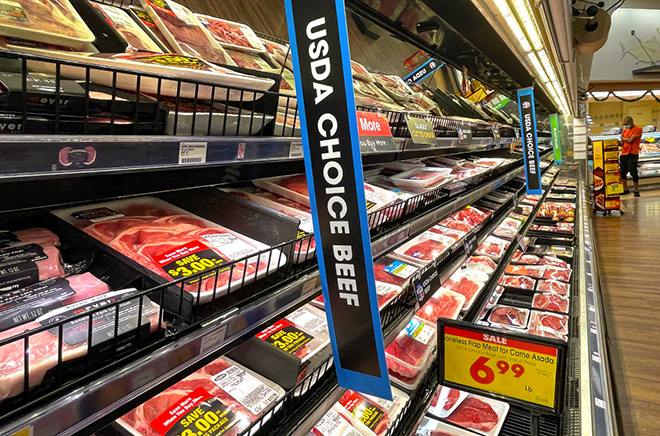S&P Global Offerings
Featured Topics
Featured Products
Events
S&P Global Offerings
Featured Topics
Featured Products
Events
S&P Global Offerings
Featured Topics
Featured Products
Events
Banking & Capital Markets
Economy & Finance
Energy Transition & Sustainability
Technology & Innovation
Podcasts & Newsletters
Banking & Capital Markets
Economy & Finance
Energy Transition & Sustainability
Technology & Innovation
Podcasts & Newsletters
S&P Global Offerings
Featured Topics
Featured Products
Events
3 Dec, 2021
 USDA Choice beef displayed for sale in a Los Angeles grocery store on Nov. 11, 2021. U.S. consumer
USDA Choice beef displayed for sale in a Los Angeles grocery store on Nov. 11, 2021. U.S. consumer
prices for food and other goods are rising.
Amazon.com Inc., Walmart Inc. and other e-commerce companies are readying an arsenal of cost-saving measures as they prepare to battle inflation well into 2022.
While the largest retailers were able to provide a hedge against higher prices in the fourth quarter in part by stockpiling high-demand items ahead of holiday sales, market economists say labor and supply-chain constraints are unlikely to abate soon, indicating rising costs will continue into next year. Facing margin pressure, retailers are expected to navigate a challenging environment by reducing supply-chain inefficiencies, selling higher-margin goods, and passing some costs on to consumers.
The Federal Trade Commission recently requested information from Amazon and other large U.S. retailers and wholesalers as the agency opened in inquiry into whether supply chain disruptions were causing higher consumer prices or harming competition.
According to the U.S. Bureau of Labor Statistics' Consumer Price Index, U.S. food prices rose 5.3% for the 12-month period ending in October. Prices for computers, peripherals and smart home assistant devices rose 8.4% over the same 12-month period, while furniture and bedding prices rose 12%.
"We still have a number of labor and capital supply constraints, and the combination of these two factors are leading to inflationary pressures," said Gregory Daco, chief U.S. economist with Oxford Economics. "The goods that are in high demand are perhaps not readily available, and so prices are higher along the supply chain and they are passed onto consumers."

Amazon executives in October said the company expects about $4 billion in extra costs during the current quarter, split largely between higher labor and freight transportation expenses.
While some of those costs could dissipate in the new year, higher wages are likely to keep labor expenses up over the long term, said Mark Shmulik, a vice president and senior internet analyst with AB Bernstein. Amazon recently raised its warehouse worker wages to $18 per hour, higher than the company's $15-per-hour minimum wage, in a bid to recruit new employees ahead of the holiday season.
"If you're now hiring someone at $18 an hour, you've got somebody sitting in that warehouse making $15 who is probably going to their manager and asking for a raise," Shmulik said. "Some of that wage inflation stays on the books."
The analyst noted that Amazon has several strategies it can employ to mitigate against inflation, including subsidizing its retail business by pulling margin dollars from its highly profitable advertising segment. Amazon's "other" category, which includes advertising revenue, grew nearly 50% in the third quarter.
"There are dollars to be had within product search advertising and brand advertising that sits on Amazon.com," Shmulik said.
Amazon is also likely to push more costs onto the consumer. The company earlier this year began charging a nearly $10 delivery fee for Whole Foods Market Inc. orders and has raised shipping costs for its third party-sellers.
"Someone has to eat the margin somewhere, and it's either going to be Amazon, the merchant seller or the customer," Shmulik said. "They are putting some of these moves in place to push that margin-compression impact out to either the sellers or the end customer."
As for Walmart and Target Corp., both saw their margins squeezed from inflationary pressures in the third quarter, but they have options to help offset higher costs, said Arun Sundaram, senior equity research analyst at CFRA.
Target, which is opening more than 100 Ulta Beauty Inc. shops within its stores, stands to benefit from drawing in higher foot traffic and encouraging more sales of discretionary items with the new store-within-a-store concept.
"Typically, discretionary products are higher margin and more profitable for retailers to sell than staples," Sundaram said. "Consumers are obviously a lot more sensitive to price increases on a box of cereal than a luxury handbag."
Target also can lean into promoting its own private label brands like Cat & Jack, which are higher-margin goods.
On the expense side, Target can shave some costs by improving productivity through automation and other initiatives, and by opening up smaller-format stores, which cuts down on overhead costs, Sundaram said.
Meanwhile, Walmart can offset the impact of some inflation by using profits from its high-margin businesses in areas such as marketing, consumer finance and health and reinvest some of that money in the form of wages, Sundaram said.
Retailers will likely absorb some of the higher costs to ensure there are enough products on shelves and customers are happy.
"If they don't, they can lose market share, and if they lose market share, that could have a longer lasting impact than just absorbing some of these higher costs," Sundaram said.

